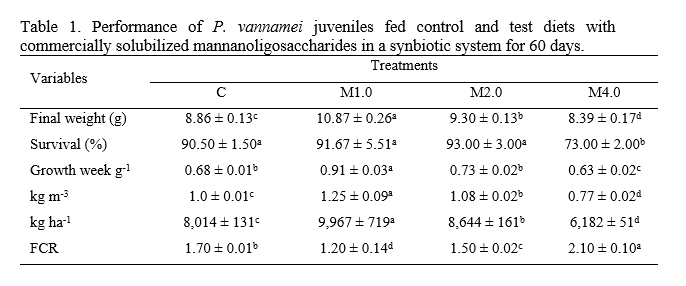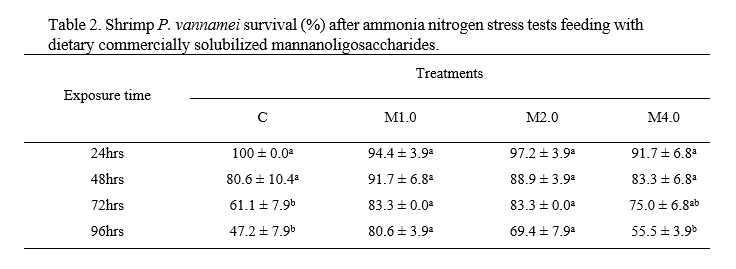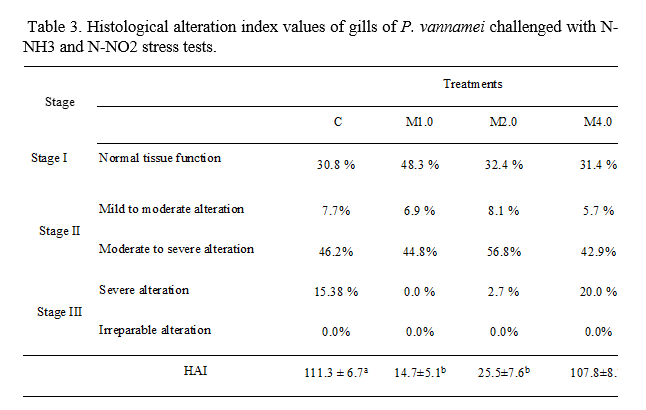EFFECTS OF DIETARY SOLUBILIZED MANNANOLIGOSACCHARIDES ON PERFORMANCE, HEALTH STATUS, NITROGEN STRESS RESISTANCE, AND ECONOMIC BENEFITS IN PACIFIC WHITE SHRIMP Penaeus vannamei RAISED IN AN INTENSIVE SYNBIOTIC SYSTEM
Introduction
As shrimp farming techniques have evolved and intensified, concerns have arisen regarding the physiological stress and immune status of farmed shrimp. Historically, chemotherapy, such as the use of antibiotics, has been used to control disease outbreaks in shrimp farming. This has resulted in the broad spread of antibiotic-resistant pathogens and significant environmental contamination. As an alternative, a new generation of MOS-based prebiotics is emerging that achieves solubilization of the mannan layer within the yeast cell wall, making it more accessible and partially exposing the glucan layer. This synergistic process enhances the overall efficacy of these prebiotics. β-Glucan is a complex polysaccharide that has been shown to have remarkable immunostimulatory, anti-inflammatory and antioxidant properties in aquatic animals. The objective of this study is to evaluate the efficacy of second-generation MOS (solubilized MOS) at different levels in the diet of P. vannamei.
Material and methods
A control diet (C) containing commercial ingredients from the Brazilian feed industry was formulated to meet the recommended nutritional requirements for juvenile Penaeus vannamei . The diet was designed to be isoproteinic (360 g kg-1), and isoenergetic (4400 k cal kg-1). The commercial mannanoligosaccharides (MOS) source consists of 27.2% solubilized mannanoligosaccharides (Hypergen, Biorigin, São Paulo, Brazil). Additionally, three experimental diets were formulated, based on the control diet, incorporating a commercial MOS source to replace wheat flour at inclusion levels of 1.0g (0.27g mannans), 2.0 (0.54g mannans), and 4.0 g (1.08g mannans), of commercial solubilized MOS per kg feed-1. These diets were designated as M1.0, M2.0 and M4.0, respectively . The study was conducted over 60 days at the Laboratório de Carcinicultura (LACAR), of the Departamento de Pesca e Aquicultura (DEPAq ) at the Universidade Federal Rural de Pernambuco (UFRPE), Brazil. During the feeding trial, the shrimps (initial weight 3.0 ± 0.04 g) were fed three times daily (8.00 am, 01:00 pm and 5:00 pm) with the experimental diets.
Results
At the end of the trial, higher performance (table 1) was observed in shrimp fed the diet supplemented with 1.0g solubilized MOS kg-1 (p < 0.05). MOS (1.0 g kg-1, 2.0 g kg-1) supplementation resulted in a significant improvement in gut morphology as evidenced by increased villus and enterocyte heights. In the ammonia (table 2) and nitrite stress tests, shrimp fed the MOS supplement showed improved resistance as indicated by higher survival rates and lower histological alterations in the gills (table 3) during stress periods. The economic benefits in the M1.0 and M2.0 treatment were the most favorable. The results show that MOS supplementation improves shrimp performance, shrimp gut health, and economic benefits.
Conclusion
To optimize economic and health benefits to P. vannamei in intensive synbiotic systems, supplementation with solubilized MOS at a level of 1.0 to 2.0 kg-1 feed is recommended.





